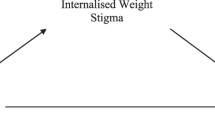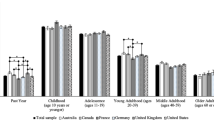Abstract
Stigmatized obese individuals tend to internalize the pervasive weight stigma, which might lead to self-discrimination (SD) and increased psychopathology. While explicit and implicit weight stigma can be measured using self-report questionnaires and Implicit Association Tests (IATs), respectively, the assessment of SD relied solely on self-report. The present study sought to develop an IAT measuring implicit SD (SD-IAT) in samples of obese individuals with and without binge-eating disorder (BED). Seventy-eight individuals were recruited from the community and individually matched in three groups. Obese participants with BED, obese participants without BED (OB) and a normal weight control group without eating disorder psychopathology (HC) were assessed with the SD-IAT and other measures relevant for convergent and discriminant validation. Results revealed significantly higher implicit SD in the BED group when compared with both OB and HC. Furthermore, significant correlations were found between the SD-IAT with body mass index, experiences of weight stigma, depressive symptoms and implicit self-esteem. Finally, implicit SD predicted eating disorder psychopathology over and above group membership, and experiences of weight stigma. This study provides first evidence of the validity of the SD-IAT. Assessing implicit SD might further increase understanding of weight stigma and its significance for psychosocial functioning among vulnerable obese individuals.
This is a preview of subscription content, access via your institution
Access options
Subscribe to this journal
Receive 12 print issues and online access
$259.00 per year
only $21.58 per issue
Buy this article
- Purchase on Springer Link
- Instant access to full article PDF
Prices may be subject to local taxes which are calculated during checkout
Similar content being viewed by others
References
Carels RA, Wott CB, Young KM, Gumble A, Koball A, Oehlhof MW . Implicit, explicit, and internalized weight bias and psychosocial maladjustment among treatment-seeking adults. Eat Behav 2010; 11: 180–185.
Roberto CA, Sysko R, Bush J, Pearl R, Puhl RM, Schvey NA et al. Clinical correlates of the weight bias internalization scale in a sample of obese adolescents seeking bariatric surgery. Obesity 2012; 20: 533–539.
Hilbert A, Braehler E, Haeuser W, Zenger M . Weight bias internalization, core self-evaluation, and health in overweight and obese persons. Obesity 2013; 22: 79–85.
Greenwald AG, McGhee DE, Schwartz JL . Measuring individual differences in implicit cognition: the Implicit Association Test. J Pers Soc Psychol 1998; 74: 1464–1480.
Wang SS, Brownell KD, Wadden TA . The influence of the stigma of obesity on overweight individuals. Int J Obes Relat Metab Disord 2004; 28: 1333–1337.
Puhl RM, Heuer CA . The stigma of obesity: a review and update. Obesity 2009; 17: 941–964.
Greenwald AG, Farnham SD . Using the Implicit Association Test to measure self-esteem and self-concept. J Pers Soc Psychol 2000; 79: 1022–1038.
Rudolph A, Schröder-Abé M, Schütz A, Gregg AP, Sedikides C . Through a glass, less darkly? Eur J Psychol Assess 2008; 24: 273–281.
Rudolph A, Schröder-Abé M, Riketta M, Schütz A . Easier when done than said! Implicit self-esteem predicts observed or spontaneous behavior, but not self-reported or controlled behavior. J Psychol 2010; 218: 12–19.
Brauhardt A, Rudolph A, Hilbert A . Implicit cognitive processes in binge-eating disorder and obesity. J Behav Ther Exp Psy 2014; 45: 285–290.
Roefs A, Huijding J, Smulders FT, MacLeod CM, de Jong PJ, Wiers RW et al. Implicit measures of association in psychopathology research. Psychol Bull 2011; 137: 149–193.
Durso LE, Latner JD . Understanding self-directed stigma: development of the weight bias internalization scale. Obesity 2008; 16: S80–S86.
American Psychiatric Association Diagnostic and Statistical Manual of Mental Health Disorders: DSM-5, 5th edn American Psychiatric Publishing: Washington, DC, USA, 2013.
Hilbert A, Tuschen-Caffier B, Ohms M . Eating Disorder Examination: Deutschsprachige Version des strukturierten Essstörungsinterviews [Eating Disorder Examination: Evaluation of the German version]. Diagnostica 2004; 50: 98–106.
Hilbert A, Tuschen-Caffier B, Karwautz A, Niederhofer H, Munsch S . Eating Disorder Examination-Questionnaire: Evaluation der deutschsprachigen Übersetzung. [Eating Disorder Examination-Questionnaire: Evaluation of the German version]. Diagnostica 2007; 53: 144–154.
Myers A, Rosen JC . Obesity stigmatization and coping: relation to mental health symptoms, body image, and self-esteem. Int J Obes Relat Metab Disord 1999; 23: 221–230.
Hautzinger M, JKeller F, Kuehner C . Beck Depressions-Inventar: Revision (BDI-II). Frankfurt, Germany: Pearson, 2006.
Greenwald AG, Nosek BA, Banaji MR . Understanding and using the Implicit Association Test: I. An improved scoring algorithm. J Pers Soc Psychol 2003; 85: 197–216.
Ashmore JA, Friedman KE, Reichmann SK, Musante GJ . Weight-based stigmatization, psychological distress, & binge eating behavior among obese treatment-seeking adults. Eat Behav 2008; 9: 203–209.
Wonderlich SA, Gordon KH, Mitchell JE, Crosby RD, Engel SG . The validity and clinical utility of binge eating disorder. Int J Eat Disord 2009; 42: 687–705.
Acknowledgements
This research was supported by Grant 01EO1001 from the Federal Ministry of Education and Research (BMBF), Germany. The work was conducted at Philipps University of Marburg, Marburg, Germany.
Author information
Authors and Affiliations
Corresponding author
Ethics declarations
Competing interests
The authors declare no conflict of interest.
Rights and permissions
About this article
Cite this article
Rudolph, A., Hilbert, A. A novel measure to assess self-discrimination in binge-eating disorder and obesity. Int J Obes 39, 368–370 (2015). https://doi.org/10.1038/ijo.2014.89
Received:
Revised:
Accepted:
Published:
Issue Date:
DOI: https://doi.org/10.1038/ijo.2014.89
This article is cited by
-
Implicit Attitudes Towards Weight, One’s Own Body and its Relation to Food in Women with Overweight and Obesity
Cognitive Therapy and Research (2022)
-
HIV Status, Obesity, and Risk for Weight Stigma: Comparing Weight Stigma Experiences and Internalization Among Adults with Obesity with and Without HIV
AIDS and Behavior (2022)
-
APOLO-Bari, an internet-based program for longitudinal support of bariatric surgery patients: study protocol for a randomized controlled trial
Trials (2016)



